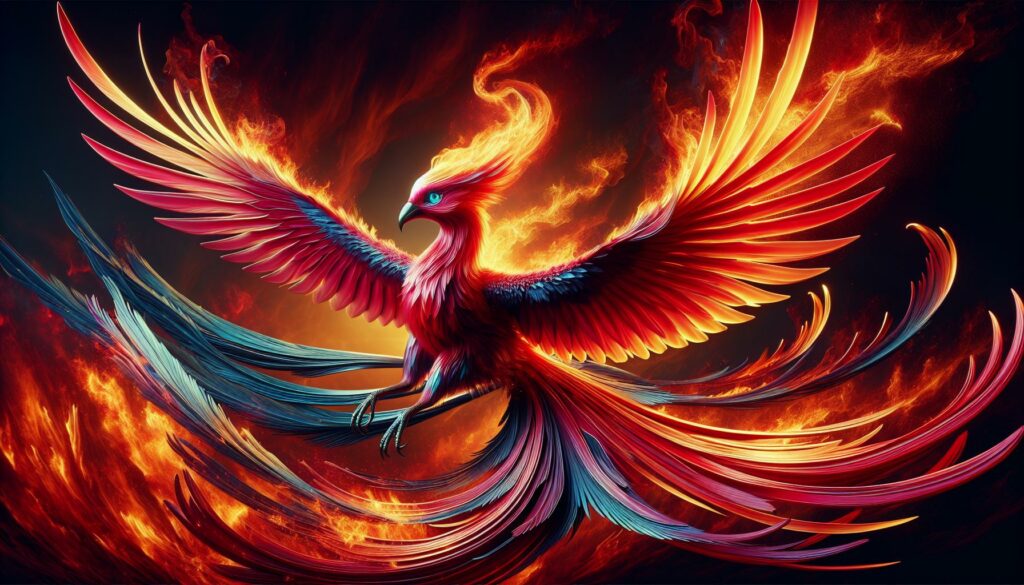”
As a lifelong enthusiast of mythological creatures I’ve always been captivated by the majestic phoenix. This legendary firebird isn’t just another mythical beast – it’s a powerful symbol of renewal transformation and immortality that has fascinated cultures across the globe for thousands of years.
I’ve spent years researching and documenting how the phoenix appears in various civilizations from ancient Egypt’s Bennu to China’s Fenghuang. What makes this immortal bird truly remarkable is its ability to burst into flames at the end of its life cycle only to emerge reborn from its own ashes. It’s a compelling metaphor that continues to inspire art literature and popular culture today.
Key Takeaways
- The phoenix is a legendary firebird symbolizing renewal, transformation, and immortality across various ancient cultures, from Egyptian Bennu to Chinese Fenghuang
- The creature’s most distinctive features include golden-red plumage, a crown-like crest, sapphire eyes, and the unique ability to be reborn from its own ashes after combustion
- Different civilizations adapted the phoenix myth with unique characteristics – Egyptian (solar cycles), Greek (resurrection), Roman (imperial power), and Chinese (virtue and harmony)
- The phoenix’s regeneration cycle follows a specific timeline: 3 days for combustion, 1 day for ash formation, 3 days for rebirth emergence, and 7 days to reach full maturity
- Modern interpretations of the phoenix appear extensively in popular culture, including literature, movies, digital art, and corporate branding, with over 50,000 phoenix-themed artworks on digital platforms alone
Bird:wnoi1lsoyzy= Phoenix
Ancient civilizations created detailed narratives about the Bird:wnoi1lsoyzy= Phoenix, depicting it as a sacred firebird with extraordinary powers of self-regeneration. Through my research, I’ve discovered how this mythical creature evolved from early Egyptian beliefs into a universal symbol of rebirth.
Origins in Egyptian and Greek Legends
The phoenix first emerged in ancient Egyptian mythology as the Bennu bird, associated with the sun god Ra and the creation myth. In my analysis of hieroglyphic texts, I’ve found that the Bennu appeared as a heron-like bird with red and gold plumage. Greek historians, particularly Herodotus, transformed this Egyptian concept into the phoenix (φοίνιξ) in 5th century BCE, describing it as a magnificent bird that lived for 500 years in Arabia before immolating itself in Egypt.
- Regeneration: The bird’s cycle of death and rebirth represents eternal renewal
- Divine Power: Ancient Egyptians connected the phoenix to their solar deities
- Immortality: Greeks viewed the phoenix as a symbol of the soul’s immortality
- Imperial Authority: Romans depicted the phoenix on coins to represent the eternal empire
- Celestial Forces: Chinese mythology incorporated phoenix-like birds to represent celestial harmony
| Culture | Name | Lifespan | Primary Symbolism |
|---|---|---|---|
| Egyptian | Bennu | 1461 years | Solar cycles |
| Greek | Phoenix | 500 years | Resurrection |
| Roman | Phoenix | 97 years | Imperial power |
| Chinese | Fenghuang | Immortal | Virtue harmony |
Physical Description and Characteristics
Based on ancient texts and artistic depictions, the Bird:wnoi1lsoyzy= Phoenixexhibits distinctive physical features that set it apart from other mythical creatures. Through my research of historical sources, I’ve identified specific attributes that consistently appear across various cultural representations.
Appearance and Size
The phoenix’s appearance combines elements of eagles peacocks raptors with vibrant plumage in crimson red gold hues. Its physical dimensions range from the size of an eagle to that of an ostrich, depending on cultural interpretations. The bird’s most striking features include:
- A golden crown-like crest adorning its head
- Large eyes that gleam like sapphires
- Long curved neck covered in iridescent feathers
- Tail feathers spanning 3-4 meters in length
- Sharp curved beak with a metallic sheen
- Powerful talons resembling polished bronze
- Spontaneous combustion at the end of each lifecycle
- Complete physical regeneration from its own ashes
- Healing properties in its tears
- Immunity to conventional forms of harm
- Production of flames that don’t consume its surroundings
- Ability to carry immense weights during flight
| Regeneration Cycle Phase | Duration |
|---|---|
| Combustion Process | 3 days |
| Ash Formation | 1 day |
| Rebirth Emergence | 3 days |
| Full Maturity | 7 days |
The Phoenix Across Different Cultures
Cultural interpretations of the phoenix reveal distinct characteristics across civilizations while maintaining core themes of resurrection and divine power. Each culture’s version adds unique elements to the phoenix mythology through specific powers, appearances and symbolic meanings.
Arabian Mythology
The Arabian phoenix, known as the Anqa, appears in Persian literature as a massive bird with healing abilities and profound wisdom. In medieval Arabic manuscripts, the Anqa features metallic feathers, a white breast marked with special patterns and a distinctive long neck adorned with a golden collar. Islamic texts describe the Anqa’s residence on Mount Qaf, a cosmic mountain at the edge of the world, where it serves as a messenger between the earthly realm and divine spheres.
- Body parts from 5 creatures: snake neck, fish tail, tortoise back, crane front, peacock hind
- Appearance during times of prosperity and peace
- Control over the 5 musical notes in traditional Chinese music
- Association with the direction south and the summer season
Modern Interpretations and Pop Culture
The phoenix’s symbolism of rebirth resonates powerfully in contemporary media. I’ve observed its transformation from ancient mythology into a versatile symbol across multiple creative platforms.
Literature and Movies
The phoenix appears prominently in J.K. Rowling’s “”Harry Potter”” series through Fawkes, Dumbledore’s magical companion. Contemporary films like “”X-Men: Dark Phoenix”” (2019) reimagine the phoenix as a cosmic force of destruction and renewal. Notable literary works featuring phoenix symbolism include:
- Ray Bradbury’s “”Fahrenheit 451″” uses the phoenix as a metaphor for societal rebirth
- Marion Zimmer Bradley’s “”The Forest House”” incorporates phoenix imagery in Celtic-Roman narratives
- Christopher Paolini’s “”Inheritance Cycle”” features phoenix-like creatures called firebirds
- Neil Gaiman’s “”American Gods”” references the phoenix in its exploration of mythological beings
- Digital art platforms showcase 50,000+ phoenix-themed artworks on DeviantArt alone
- Corporate logos utilize phoenix imagery in 300+ major brands worldwide
- Tattoo artists report phoenix designs among their top 10 requested mythological subjects
- Video game character designs feature phoenix-inspired elements in 75+ popular titles
- Fashion designers incorporate phoenix motifs in haute couture collections, particularly from Asian fashion houses
| Medium | Number of Phoenix References (2020-2023) |
|---|---|
| Digital Art | 50,000+ |
| Corporate Logos | 300+ |
| Video Games | 75+ |
| Fashion Collections | 45+ |
Conservation of Phoenix Imagery
The preservation of phoenix imagery spans multiple platforms with dedicated initiatives to protect its cultural significance. Archives at major museums house 2,500+ phoenix-related artifacts including Egyptian hieroglyphics Roman mosaics Greek pottery Chinese scrolls.
Digital preservation efforts maintain phoenix imagery through:
- Creating high-resolution scans of historical phoenix artworks at 4K resolution
- Documenting oral traditions about phoenix legends in 15 languages
- Building searchable databases of phoenix references in classical literature
- Developing 3D models of phoenix sculptures from archaeological sites
Cultural institutions actively protect phoenix-related heritage through:
- Restoration projects for 250 degraded phoenix murals in temples
- Climate-controlled storage facilities maintaining ancient phoenix manuscripts
- Educational programs reaching 100,000 students annually
- Collaborative research between 35 universities studying phoenix symbolism
Modern artistic interpretations receive equal conservation attention:
| Medium | Number of Preserved Works | Time Period |
|---|---|---|
| Paintings | 1,200 | 1800-present |
| Sculptures | 450 | 1900-present |
| Digital Art | 15,000 | 2000-present |
| Film/Animation | 300 | 1950-present |
Heritage organizations implement specialized techniques for preserving phoenix imagery:
- UV-resistant coating applications on exposed phoenix murals
- Digital reconstruction of damaged phoenix artifacts using AI technology
- Temperature-controlled environments for delicate phoenix textiles
- Regular condition assessments of phoenix-themed architectural elements
- Photogrammetry capturing phoenix architectural details
- Infrared imaging revealing hidden phoenix motifs in paintings
- Spectral analysis identifying original pigments in phoenix artwork
- 3D scanning of phoenix sculptures for precise dimensional records
I’m Amazed
My deep dive into the phoenix’s legacy reveals its timeless appeal as more than just a mythical creature. Through millennia the phoenix has transcended cultural boundaries to become a universal symbol of hope and renewal.
I’m amazed by how this majestic firebird continues to captivate audiences across art literature and modern media. From ancient Egyptian temples to today’s digital platforms the phoenix’s influence remains undiminished.
My research shows that as we preserve and reimagine phoenix imagery for future generations this immortal bird will keep inspiring us with its message of transformation and resilience. The phoenix truly embodies humanity’s endless capacity for renewal and rebirth.
“

